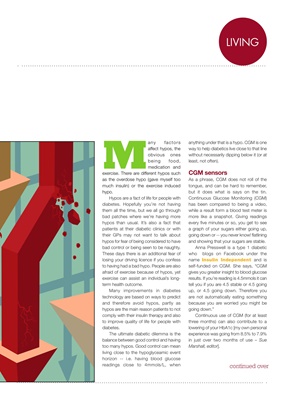
continued over
Many factors
affect
hypos, the
obvious ones
being food,
medication and exercise. There are
different hypos such as the overdose
hypo (gave myself too much insulin) or the
exercise induced hypo.
Hypos are a fact of life for people with
diabetes. Hopefully you're not having
them all the time, but we all go through
bad patches where we're having more
hypos than usual. It's also a fact that
patients at their diabetic clinics or with
their GPs may not want to talk about
hypos for fear of being considered to have
bad control or being seen to be naughty.
These days there is an additional fear of
losing driving licence if you confess to
having had a bad hypo. People are also
afraid of exercise because of hypos, yet
exercise can assist an individual's longterm health outcome.
Many improvements in diabetes
technology are also based on ways to
predict and therefore avoid hypos, partly
as hypos are the main reason patients to
not comply with their insulin therapy and
to improve quality of life for people with
diabetes.
CGM sensors
CGM does not roll of the tongue, and can
be hard to remember, but it does what
is says on the tin. Continuous Glucose
Monitoring (CGM) has been compared to
LIVING
being a video, while a result form a blood
test meter is more like a snapshot. Giving
readings every five minutes or so, you get
to see a graph of your sugars either going
up, going down or -- you never know!
flatlining and showing that your sugars
are stable.
Anna Presswell is a type 1 diabetic
who blogs on Facebook under the name
Insulin Independent and is self-funded
on CGM. She says, "CGM gives you
greater insight to blood glucose results. If
you're reading is 4.5mmols it can tell you
if you are 4.5 stable or 4.5 going up, or
4.5 going down. Therefore you are not
automatically eating something because
you are worried you might be going
down."
Continuous use of CGM (for at least
three months) can also contribute to a
lowering of your HbA1c [my own personal
experience was going from 8.5% to 7.9%
in just over two months of use - Sue
Marshall, editor].
Medtronic's MiniMed Veo is the only
pump clinically proven to reduce hypos.
It is CGM plus LGS enabled to keep
you safe (CGM is continuous glucose
monitoring while LGS is low glucose
suspend). These are used together to
work towards a closed loop system.
There are CGM and LGS trials now taking
place. LGS turns off your insulin dose for
two hours (unless you choose put it back
on again).